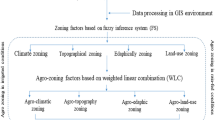Abstract
Rice is one of the most preferred food crops in Nigeria. However, local rice production has declined with the oil boom of the 1970s causing demand to outstrip supply. Rice production can be increased through the integration of Geographic Information Systems (GIS) and crop–land suitability analysis and mapping. Based on the key predictor variables that determine rice yield mentioned in relevant literature, data on rainfall, temperature, relative humidity, slope, and soil of Oyo state were obtained. To develop rice suitability maps for the state, two MCE-GIS techniques, namely the Overlay approach and weighted linear combination (WLC), using fuzzy AHP were used and compared. A Boolean land use map derived from a landsat imagery was used in masking out areas currently unavailable for rice production. Both suitability maps were classified into four categories of very suitable, suitable, moderate, and fairly moderate. Although the maps differ slightly, the overlay and WLC (AHP) approach found most parts of Oyo state (51.79 and 82.9 % respectively) to be moderately suitable for rice production. However, in areas like Eruwa, Oyo, and Shaki, rainfall amount received needs to be supplemented by irrigation for increased rice yield.







Similar content being viewed by others
References
Adebayo AA (2002) Agroclimatic classification of Adamawa State, Nigeria for upland rice production. Nigeria Geograph J 3(4):83–95
Akinbile C (2009) Behavioural pattern of upland rice agronomic parameters to variable water supply in Nigeria. J Plant Breed Crop Sci 2(4):073–080
Akintola JO (1983) An analysis of the effects of agroclimatic factors on food crop yields in Ibadan area of Oyo state. PhD Dissertation Department of Geography, University of Ibadan
Ali K (2010) Land suitability evaluation using fuzzy continuous classification: a case study of Ziaran region. Modern Applied Science 4(1)
Areola O (1978) Soil and vegetal resources in Filani et al (eds). A Geography of Nigerian Development, 105-125.Heinemann Educational Books Limited, Nigeria.
Ayoade JO (2005) Introduction to agroclimatology. University Press Plc, Nigeria
Babalola TS et al (2011) Land evaluation studies of two wetland soils in Nigeria. Int Res J Agri Sci Soc Sci 1(6):193–204
Babatolu JS, Olaniran OJ (1987) Climate and the growth of sorghum at kabba, Nigeria J. Agric Meteorol 42:301–308
Clark GR (1951) The evaluation of soils and definition of quality class from studies of the physical properties of the soil profile in field. Journal of Science 2(1):50-60
Dengiz O et al (2010) Application of GIS model in physical land evaluation suitability for rice cultivation. The Anatolian Journal of Agricultural Sciences 25 (3)
Dengiz O (2013) Land assessment for rice cultivation based on GIS modeling. Turk J Agric For 37:326–334
Dengiz O, Ozyazici MA, Saglam M (2015) Multicriteria assessment and geostatistical approach for determination of rice growing suitability sites in Gokirmak catchment. Paddy Water Environ 13(1):1–10
Filani MO (1980) Rice in the Nigerian economy: a geo-economic analysis. Nigerian J Econ Soc Stud 22(1):145–173
Gbadegesin A (1986) A method for identifying soil properties influencing crop yield, the example of maize in the savanna belt of South-Western Nigeria. Geoforum 17(1):109–118
Gbadegesin A (1987) Soil rating for crop production in the savanna belt of South-western Nigeria. Agric Syst 23:27–42
Gbadegesin A, Nwagwu U (1990) On the suitability assessment of the forest and savanna Ecological Zones of South-western Nigeria for maize production. Agric Syst 16:7–20
Hussain W, Sohaib O (2012) Geographical Information System based model of land suitability for good yield of rice in Prachuap Khiri Khan province, Thailand. Sci Technol Dev 31(1): 1--9
Imolehin ED, Wada AC (2000) Meeting the rice production and consumption demands of Nigeria with improved technologies. National Cereals Research Institute, Nigeria
Isitekhale HHE et al (2014) Soil suitability evaluation for rice and sugarcane in lowland soils of Anegbette, Edo State, Nigeria. Int J Eng Sci 3(5):54–62
Kihoro J et al (2013) Suitability analysis for rice growing sites using a MCE and GIS approach in Great Mwea region, Kenya. Springer Plus 2:265
Maddahi Z et al (2014) Land suitability analysis for rice cultivation using MCE approach and GIS. Eur J Exp Biol 4(3):639–648
Mustafa AA et al (2011) Land suitability analysis for different crops: a multicriteria decision making approach using remote sensing and GIS. Researcher 3(12)
Nuga BO and Akinbola GE (2010) Soil survey information for sustainable agriculture in Ikwuano local government area, Abia state, Nigeria. Second RUFORUM Biennial meeting 20-24 september, 2010, Ontebbe, Uganda
Oche CY (1998) Agroclimatic zonation for wheat production in the savanna region of Nigeria. Singap J Trop Geogr 19(1):39–49
Olaf E (2003) Rice production systems in Nigeria: a survey. WARDA, Abidjan
Olaniyi AO et al (2015) Agricultural landuse suitability assessment in Malaysia. Bulgarian J Agri Sci 21(3):560–572
Omotayo AM (2007) Mapping of ofada rice production areas. The PrOpCom monograph series No 15. Department for International Development, UK
Saaty TL (1977) A scaling method for priorities in hierarchical structures. J Math Psychol 15(3) : 234--281
Sezer I and Dengiz O (2014) Application of a multicriteria decision-making approach for rice land suitability analysis. Turkish Journal of Agriculture and Forestry Vol.38, Issue 6.
Shamla R et al (2010) Agro land suitability assessment for rice and sugar cane using remote sensing and GIS synergism. www.GeospatialWorld.net Accessed 2011.
Hu S (2003) Analyzing Rice Production Potential in the Midwest and Great Plains states of the United States: a geographic information system approach. Proceedings for Workshop and Conference on World Japonica Rice Marketing and Production Potential
Yu J et al (2009) Cellular automata and GIS based landuse suitability simulation for irrigated agriculture. 18th World IMACS/MODSIM congress,Cairns, Australia 13-17 July 2009. Cooperative Research Centre for Irrigation Futures, Austalia
Author information
Authors and Affiliations
Corresponding author
Rights and permissions
About this article
Cite this article
Ayoade, M.A. Suitability assessment and mapping of Oyo State, Nigeria, for rice cultivation using GIS. Theor Appl Climatol 129, 1341–1354 (2017). https://doi.org/10.1007/s00704-016-1852-4
Received:
Accepted:
Published:
Issue Date:
DOI: https://doi.org/10.1007/s00704-016-1852-4




